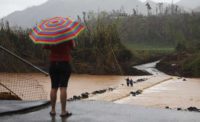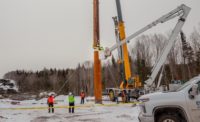A spate of rare winter tornadoes across Texas and the Southeast has rekindled long-standing concerns about construction quality and building code enforcement, particularly in areas that appear increasingly vulnerable to severe weather.
The issue gained national exposure after a string of 12 confirmed tornadoes swept across North Texas on the afternoon and evening of December 26, killing 13 people and causing an estimated $1.2 billion worth of damage, according to the Insurance Council of Texas.
One twister struck a steel-framed elementary school in Glenn Heights, 16 miles south of Dallas, blowing out exterior metal stud cladding walls in three directions. Timothy Marshall, a principal engineer and meteorologist with Dallas-based Haag Engineering, who visited the site as a National Weather Service volunteer inspector, discovered numerous improper foundation connections, a condition that apparently dated back to the building’s construction in 2008.
In one instance, a steel bottom plate had been attached with a nail, rather than bolted into place. Other connections were non-existent.
“I saw no roof attachments, nor were several of the interior walls connected with each other,” Marshall says. Though he estimated the storm’s winds had reached 85 to 90 miles per hour, “the walls shouldn’t have failed like this.”
Marshall shared his findings with the Red Oak Independent School District, which is conducting its own investigation.
The contractor, Ratliff Constructors of Addison, Texas, did not respond to interview requests. Company president Max K. Young defended the firm’s work in a statement, saying that the school was constructed in accordance with provided contract documents, including “engineered metal stud shop drawings that support and confirm the design intent of the plans and specifications which was based on ASCE 7-05 wind design (90 mph).”
Mark Peterman, principal and vice president of L.A. Fuess Partners of Dallas, confirmed via email that while his firm was engineer of record for the school’s foundation and superstructure, “the metal stud cladding design and shop drawings were produced, signed, and sealed by a Specialty Structural Engineer contracted to a member of the Construction Team.”
Young’s statement added “all exterior and interior wall construction was inspected and approved by a third-party inspection firm at numerous intervals throughout the construction process,” and that drywall and wall sheathing were installed only after receiving verification from the inspection firm that the metal- stud framing system had been properly installed.
Though Texas has adopted the International Building Code for commercial construction, municipalities determine whether to adopt the code as is, or with amendments such as those developed by the North Central Texas Council of Governments’ Regional Code Council.
According to Glenn Heights’ website, the city adopted the NCTCOG-amended IBC 2006 code for commercial construction in 2009. More recent IBC editions call for increased wind design speeds, and require tornado shelters in all new schools and emergency response centers across the Midwest.
Code enforcement in Texas is likewise left to municipalities. Jim Olk, Building Official for the City of Garland, notes that uniform enforcement has been “a long-running discussion” within the state.
“Many times, issues come up and legislative bills are proposed that impact code adoption and code enforcement throughout the state,” Olk says. “Not many make it through to law for a myriad of reasons.”
William Coulbourne, a Delaware-based consulting structural engineer also found numerous examples of non-compliant construction while researching ASCE’s recently released report on building performance during the EF5 tornado that struck Moore, Okla., in 2013. Like Marshall, he said it’s often difficult to pinpoint responsibility for the deficiencies.
“But we clearly have to do a better job of compliant construction if we want better building performance,” he says.








Post a comment to this article
Report Abusive Comment